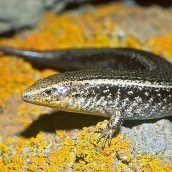Gran Canaria Skink (Chalcides sexlineatus)
This skink has a head and body length of around 92 mm in males and 99 m in females, with a total length, including the tail, of 150 mm. It has strong legs and a flattened body; the neck and head (which is broad and triangular) are well-differentiated from the body. Colouring varies considerably according to individual and geographical location. Some skinks have blue or metallic greenish-blue tails and four yellowish-brown lines on the dorsum (C. s. sexlineatus), while others have a brown back with greyish-white patches arranged longitudinally and a brown tail (C. s. bistriatus). Endemic to Gran Canaria, the typical subspecies is widely distributed in the south-southwest of the island, while the C. bistriatus is found in the north and east, although there are intermediate forms in several areas. Recently it has been deliberately introduced in La Palma. In Gran Canaria it lives in all kinds of habitats from the shoreline to the highest peaks, in lowland Euphorbia communities to pine forests and their potential domains; it is also present on Roque de Gando. It generally finds shelter under rocks and in stone walls. Its diet is very similar to that of other Canary Island skinks and includes insects (ants, small beetles, etc.), spiders and larvae, and less frequently fruit and snails. This skink is ovoviviparous, the females breed in July and August and give birth to a litter of 2-7 young from September on. Because this reptile is abundant and widely distributed, it is not considered endangered, although it is negatively affected by predation by cats established in the wild and other introduced mammals, as well as by chemicals used in agriculture.













